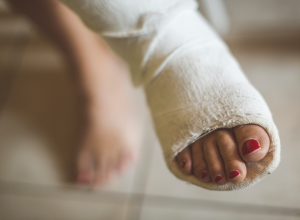
Bone Fracture
Bone fracture is the medical term for a broken bone, a common injury that usually occurs about twice in a person’s life. The severity of a bone fracture can range from less serious avulsion injuries like those resulting from a trip or fall, to complicated injuries like the shattering of the tibia or fibula of the ankle, or a comminuted fracture (when the bone splinters into more than two fragments, which is often caused by vehicular accidents).
Causes
Bone fractures occur when a physical force, high impact stress or trauma exerted on the bone is stronger than the bone itself. This causes the bone to snap, crack or shatter. Most people would call the condition a broken bone, but doctors use the term bone fracture.
Bone fractures are very common in children, whose bones are fairly weak and still developing. Kids often experience Greenstick fractures, in which the bone bends but does not completely break. However, bone fractures frequently occur in adults, as well. Bones become more brittle as we age, leaving them more susceptible to breakage.
People who have medical conditions that weaken the bones have a higher chance of experiencing bone fractures. These conditions include bone cancer, osteoporosis and ankylosing spondylitis (an inflammatory disease of the musculoskeletal system). Bone fractures caused by underlying disease are called pathologic fractures.
People who smoke also have a higher risk of experiencing broken bones. This is because smokers tend to have lower bone density than non-smokers. Additionally, studies have shown that it takes many smokers double the amount of time to recover from bone fractures than those who do not smoke.
Symptoms
Bones do not contain nociceptors, meaning the bone itself is unable to feel pain. However, a broken bone is a very painful condition for many reasons. First of all, bones are covered with a membrane that does feel pain, so breaks of this membrane (called the periosteum) can create extreme discomfort. The muscles may begin to spasm in order to try and hold the bone fragments in place, and soft tissue surrounding the area may begin to swell and create pressure pain.
Most people experience the following symptoms after fracturing a bone:
- Pain at the site of the broken bone
- Significant swelling
- Bruising
- Immobility of the body part affected
Sometimes the broken bone will actually protrude through the skin. This is called an open fracture, and it requires immediate medical attention to avoid infections and extended recovery time.
Treatment
If you suspect you’ve suffered a bone fracture, you should seek medical attention right away. Sites like MedlinePlus, MedicineNet and WebMD agree that if your regular doctor (or podiatrist or orthopedic surgeon in the case of foot and ankle fractures) isn’t available, go to the emergency room and then follow up with your regular doctor. In the meantime, most doctors advise following the RICE protocol, which is resting the affected area, applying ice to control swelling, using a compression wrap to further control swelling and elevating the affected area slightly above the level of your heart.
When seeking medical care, be aware that most bone fractures are treated with conservative, non-surgical treatment that includes pain management (with medication like ibuprofen) and immobilization (with either a plaster or fiberglass cast or splints). Surgical methods for treating bone fractures are usually reserved for extreme fractures and/or fractures in which conservative treatment has failed or is likely to fail. Occasionally bone grafting is used to treat the condition, as are metal implants, plates and screws.
Healing Time
Recuperation time varies greatly depending on which bone was fractured and the health and age of the patient. Most children heal within a couple of weeks, while aging adults may face several months of recovery time.
Whether your doctor recommends conservative or surgical treatment, it’s important that you follow his or her instructions when it comes to after treatment. Doing so can help you avoid complications like osteomyelitis (infection of the bone), arthritis, malunion (when the bone heals in a less than optimal position), possible deformity and chronic pain.
Notice concerning medical entries:
Articles having medical content shall serve exclusively for the purpose of general information. Such articles are not suitable for any (self-) diagnosis and treatment of individual illnesses and medical indications. In particular, they cannot substitute for the examination, advice, or treatment by a licensed physician or pharmacist. No replies to any individual questions shall be effected through the articles.

















